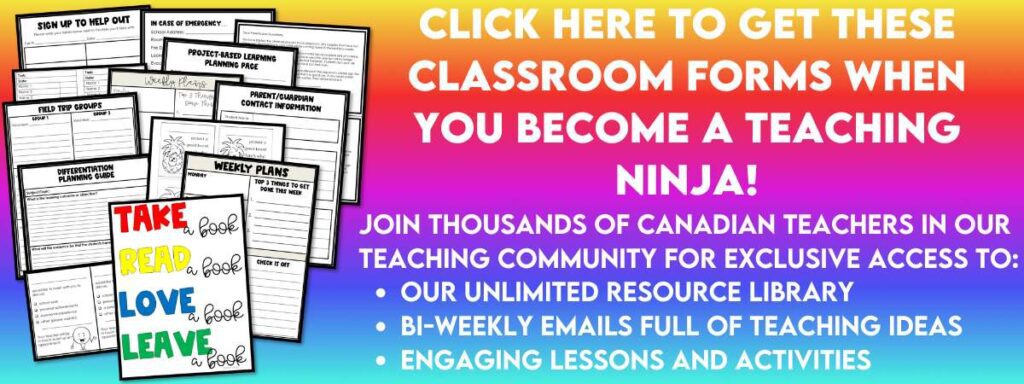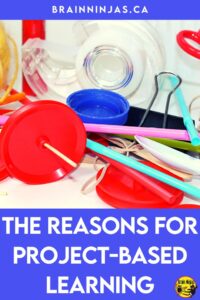
Project-based learning can be a challenge because it moves the control from the teacher to the student. When we began our teaching journey, controlling every aspect of student work from beginning to end seemed like the right thing to do. As we’ve evolved as teachers, we learned that loosening the reigns has many benefits. Check out some of the best reasons we use project-based learning in our classroom.
What is Project-Based Learning?
Project-based learning, or PBL, is an approach to learning where students create projects while learning communication, collaboration, creative thinking and critical thinking skills. Rather than teaching a unit and then creating a project, the project becomes the lesson and the final result sums up the learning done by the student. Keep reading to hear about the benefits of using Project-Based Learning in your classroom.
Why Use Project-Based Learning?
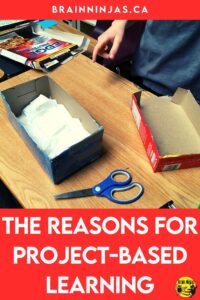
This style of learning often works for students who don’t respond to traditional lecture-style learning. It helps them grasp an understanding on a deeper level and make connections to the real world.
It uses multiple means of engagement
When you allow students to make decisions about how they learn, the engagement goes through the roof. It’s hard to know what things to allow students to choose, but we always start with the basics. If the assessment is based on content, the method in which that content is delivered or the learning is expressed takes a back seat. If we want to know what our students know about the Vikings, they can show this to us by writing a paragraph, recording a video, drawing a cartoon or performing a play. When students choose, they win (and if the teacher is only assessing the content — not the method of delivery — then assessment is the same whether it’s a play or a poster).
Students do the work, not the teacher
Instead of teachers having to be responsible for finding, researching and organizing all the content, students become responsible for this. Of course, students need to be taught how to do this over a school year, so the first project of the year shouldn’t be an all-inclusive unit. Start small. Choose one concept and have students learn about it and teach each other. Between videos on YouTube, textbooks and all the resources available on the web, it’s easy for students to locate information. Your role as the teacher becomes one of helping students navigate and become responsible researchers and digital citizens.
The learning happens during the project
In most classrooms, projects are done at the end of the unit. What if the project WAS the unit? As long as the teacher is clear about the objectives for the knowledge and skills that need to be acquired, there is no need to fill students up with worksheets and reading pages only to give them a big project at the end. This does require students to be accountable throughout the project and teachers need to know exactly what point students are at during the project, but with regular check-ins and feedback for students, the learning can happen more authentically.
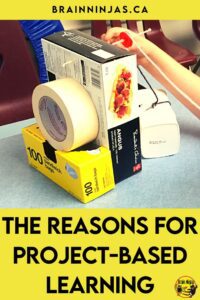
Students are making real connections
Students do not connect with worksheets. They like to feel the work they do is genuine and that they are interestingly learning new skills. Our students are 21st-century learners and we need to give them opportunities to collaborate, learn, speak, present and challenge themselves. Remember, we are teaching them to do jobs that don’t even exist yet. They need a set of versatile skills.
Differentiation happens naturally
When students make choices about what they are learning, they tend to choose activities that naturally show off their strengths or overcome their learning challenges. This puts the onus on students to make these decisions, thus making less work for the teacher to try to accommodate all the different learning needs. When you teach students to advocate for their own needs, they are in control of their learning.
How Do You Include Project-Based Learning in Your Classroom?
Students will not naturally know how to work independently on projects. They don’t naturally know how to work in groups and collaborate. These are skills they need to learn and you need to explicitly teach. We do this by creating small challenges where students learn these skills and practice.
If you’re looking to keep students on track, check out our post How to Keep Students Accountable During Project Based Learning.
We created lots of small challenges that relate to the different content areas we teach. For example, when working on simple machines, we created a series called Simple Machines STEM Challenges that we could do over the week so students could learn to work together. These little activities were practiced for a much larger project. Our students practiced working through the planning stages, creating stages and presentation stages. We gave regular feedback about how students could improve at each stage and as the week continued, they got better and better. You can find the Simple Machines STEM Challenges in our TpT Store ($USD) or our BN Shop ($CAN).
By the time we were ready to do a larger project, our students were quite confident and ready to work. Read more about Critical Thinking Challenges
Do you need a little help getting started? You can get our free Tips & Tricks for Project-Based Learning by signing up for our email list. It can also be found in our Resource Library, along with many other general classroom forms to help you organize your classroom.
To Set Up Your Classroom
We search out every possible resource that students may be able to use. This includes maps, photographs, books, textbooks, atlases, web pages, public library resources, archive resources, cameras, devices, and people who may be able to help (for interviews or historical knowledge).
How We Prepare the Ourselves
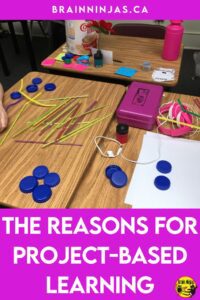
We set a general timeline and set out time in the schedule for large amounts of work time. Plan for how our early finishers will use their extra time (digging deeper) and how we will help our time-challenged students manage their time. We read through the entire assignment and decide which teacher tools (like rubrics) and student tools (like planning pages) will be used. We also decide which types of projects and tools will be permitted and which choices we will allow (or how we will address outside-the-box ideas).
How We Prepare Our Students
Outline the task and get students excited about the possibilities by showing them examples of other projects (even when they are a different topic, they can be inspiring). Discuss the criteria and requirements for the task and give students information about where to find information. Set out a timeline and then allow students to work.
During the Project
We check in with students using a checklist of class names to make sure we check in with everyone. When a few students are struggling with a similar part of the task, we sometimes pull them together into a small group session where they can talk out the issues and get a bit of help from their peers or us. We give quality feedback to students during their projects so they can change things as they go.
What If You Don’t Have Time to Create the Projects for Students to Do?
We’ve got you. We create all kinds of projects for our students (and they even come up with some of their own). If you’re ever thinking about a project but don’t have time to create it on your own, reach out to us.
Science and social studies are subjects that lend themselves naturally to project-based learning. These projects come with many choices to allow students to research and present their learning. Projects are balanced throughout the school year, so there is only one project going on at a time, but occasionally they overlap depending on the length. Quite often, it’s our presentations that are wrapping up just as we get going on different projects. Sometimes, one group of students is ready to move on, while another group needs a little more time — it happens. None of our students are ever working on the same thing at the same time, but that’s a whole other post.
These are some of our most popular projects.
Design a Fur Trading Post
Use project-based learning and teach your students about the Canadian fur trade through this great project that comes with planning pages, rubrics, a checklist and all kinds of examples. The project starts by learning about where a new post would be based on geographical thinking skills. Students then need to create a visual representation of their post and write a letter to their new boss about how the new post is working out. Students are encouraged to use all their skills to show all the things they learn about the fur trade. We’ve had projects created from Lego, Minecraft, sticks, paper and clay. Students LOVE this one and we do it every year. The projects just keep getting better and better.
Find this project in our TpT Store ($USD) or in our BN Shop ($CAN).
Design a Prairie Homestead
Learn about how the prairies of Canada were settled by having students learn about the lives of the colonists who lived on the first homesteads in Alberta and Saskatchewan after Indigenous People were removed. This resource starts with a lesson about natural resources and how Indigenous People were impacted by westward expansion.
Students will locate their homestead, create a visual representation of their land and then write a letter to the ones they left behind telling them all about life in their new home. This complete resource comes with everything a teacher needs to get their students to work-except you still have to collect the resources to research homesteads. We use things like textbooks, books and websites to get going. Our students LOVE this one-especially if they love creating things with Lego or with Minecraft.
Find this project in our TpT Store ($USD) or in our BN Shop ($CAN).
Design an Indigenous Shelter
Have students research different shelters and their purposes by different groups of Indigenous People in Canada. Students will design a museum display to teach the public about the shelters and dwellings and their purposes.
This resource includes everything you need to get students started researching a specific shelter used as a home, for hunting for shelter when away from home. You will need to collect materials students can use to research, but everything else is included, such as checklists, planning pages and rubrics.
Find this project in our TpT Store ($USD) or in our BN Shop ($CAN).
Shape and Space Arcade
We used math skills to create a cardboard arcade. Learn more about it in our post, Mastering the Angles: Innovative Approaches to Teaching Geometry Concepts.
Science is Great for Project Based Learning, Too
We’ve done many different projects over the years. Some take an afternoon and others are much bigger. Check out some of these.
Design a Carnival Attraction Find this project that works well in a science unit about simple machines in our TpT Store ($USD) or in our BN Shop ($CAN).
Electricity STEM Challenges Find these challenges in our TpT Store ($USD) or in our BN Shop ($CAN). We also have a post about Designing Electrical Game Boards.
Create a Waste Reduction Plan Find this project in our TpT Store ($USD) or in our BN Shop ($CAN).
Design a Plant Activity Find this project in our TpT Store ($USD) or in our BN Shop ($CAN).
Plant Growth Observation Activity (students grow actual plants to learn about their needs) Find this project in our TpT Store ($USD) or in our BN Shop ($CAN).
Chemistry STEM Challenges Find these projects in our TpT Store ($USD) or in our BN Shop ($CAN).
Astronomy STEM Challenges Find these projects in our TpT Store ($USD) or in our BN Shop ($CAN).
Is There a Downside to Project-Based Learning?
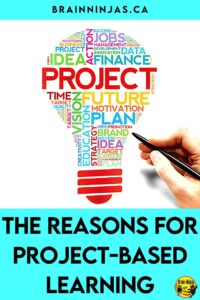
Honestly, it can be messy
Our classroom is often covered in cardboard and materials everywhere, but the kids are learning and that’s the job.
It takes organization
If you struggle with being organized, it can be a challenge to take this on. It takes preparation up front, but then students take over. It’s worth a try (and it might even help your organization skills!)
It’s noisy
Collaboration means talking, which means noise. While you can teach students to communicate a little quieter, productive noise is part of the process.
It requires strong classroom management
You have to be very clear with your expectations, hold students accountable and follow up with consequences and praise. Students will meet your expectations, so if you expect them to fail, they will. But, if you show interest and give them quality feedback, they will surprise you.
It takes time
Yes, it takes time because students will not complete projects as fast as you want to pace lessons. However, the learning is deeper and more meaningful. They will learn what they learn better than any worksheet or quick lesson. They will get more efficient as they go. And we’ve noticed that the more a student loves a task, the longer they will stick with it.
What are your experiences with project-based learning? Share your thoughts and ideas with us in the comments below. Happy learning!

